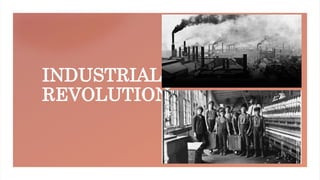
Industrial Revolution Revision Powerpoint
- 2. The Industrial Revolution was the transition from creating goods by hand to using machines. 3/1/20XX SAMPLE FOOTER TEXT 2
- 3. 3/1/20XX SAMPLE FOOTER TEXT 3 Technology: The Industrial Revolution first took off as a result of two developments in technology. The first was the invention of a number of new machines designed to process raw cotton into cloth. The second development was the invention of steam engines capable of powering these cotton-processing machines. Agricultural revolution: New methods of farming were gaining popularity, improving the quantity and quality of food and the output of fibres such as wool for clothing. Changes in land ownership meant that common land that had been shared by villagers was enclosed by wealthy landowners, creating larger farms on which the new farming methods could be applied.
- 4. 3/1/20XX 4 Access to raw materials: Steam engine operation depended heavily on good-quality coal to provide strong reliable heat. Britain had large deposits of coal, most of which were readily accessible, so mining developed alongside the growth in factory production. Wealthy middle class: In medieval Europe and Britain, the vast majority of the population consisted of lower-class peasants who worked the land owned by the upper-class aristocracy. As Britain grew to become a major trading nation, many members of the middle class became very wealthy and used their savings to invest in business ventures. It was this investment that funded the growth of factories during the Industrial Revolution.
- 5. 3/1/20XX 5 Transport: The transportation of raw materials to factories and of finished products to customers, both local and overseas, was relatively simple. River transport was very efficient, and canals could be built to connect many of these rivers. The development of steam as a means of locomotion eventually transformed transport networks across Britain and later the world. Expanding Empire: Since the great age of exploration in the sixteenth century, European ships and merchants had sailed to all parts of the world and had discovered a wide variety of new products that could be imported into Europe. The British were quick to realise the possibilities of importing raw materials from their colonies and transforming them into finished products to sell to the increasing population.
- 6. From around 1750 – 1850 3/1/20XX SAMPLE FOOTER TEXT 6
- 7. Open Field System; The traditional open-field village was based on subsistence farming, producing only enough food for its inhabitants, who were peasants or tenants of the landowner. It usually involved the rotation of different activities across three large fields. One field would carry a crop of wheat or rye, and one a crop of barley, while one would be allowed to lie fallow. Each year the crops would be rotated, so each field would lie fallow for one year in every three. 3/1/20XX SAMPLE FOOTER TEXT 7 Enclosed System: Enclosure involved the consolidation of open fields into single farms, owned by one farmer and separated from neighbouring farms by hedges or low stone walls. The four-crop rotation system divided the farms into four fields, with wheat in the first, turnips in the second, barley in the third and clover in the fourth. Each year the crops would be rotated by one field, this rotation continued over a four-year cycle. The four-crop rotation helped replace nutrients in the soil, and therefore helped produce better crops the following year. The plants could also be used to feed the livestock which meant they no longer had to be slaughtered.
- 8. Many 18th-century towns were grimy, overcrowded and generally insanitary places. London in particular suffered badly from dirt and pollution, so much so that candles were sometimes required at midday in busy shops owing to the smoggy conditions outside. Scores of street sellers ‘cried’ merchandise from place to place, advertising the wealth of goods and services on offer. Milkmaids, orange sellers, fishwives and piemen, for example, all walked the streets offering their various wares for sale, 3/1/20XX SAMPLE FOOTER TEXT 8
- 9. Factories and mines were dangerous and unhealthy. There was poor light, ventilation and many machines were not fenced and therefore dangerous. 3/1/20XX SAMPLE FOOTER TEXT 9
- 10. Hurriers: carry baskets or tow trucks of coal to the surface. Girls as young as six or seven. They had a belt or chain around their waste that could damage pelvic bones and many of their children would die during childbirth later on because of this Trappers: Open and close the ventilation doors in underground tunnels could sit in the dark for up to 14 hours a day Piercers: Lean over spinning machine and repair broke threads – while the machine was running. They could walk up to 30kms a day Scavengers: 3/1/20XX 10
- 11. Flying Shuttle: John Kay’s flying shuttle made weaving more efficient, and it could then take the output of up to a dozen spinners to supply the necessary yarn for one weaver. Spinning Jenny: The development of the spinning jenny in the 1760s responded to this need. Early models could spin eight spindles of yarn simultaneously, and later models were able to hold more than 100 spindles at one time. 3/1/20XX SAMPLE FOOTER TEXT 11
- 12. Created progress where previously there hadn’t been any – increased life expectance, safer jobs, earning power was increased, improvements in industries such as agriculture, textile etc., raised the standard of living, greater access to food and prices were better. 3/1/20XX SAMPLE FOOTER TEXT 12